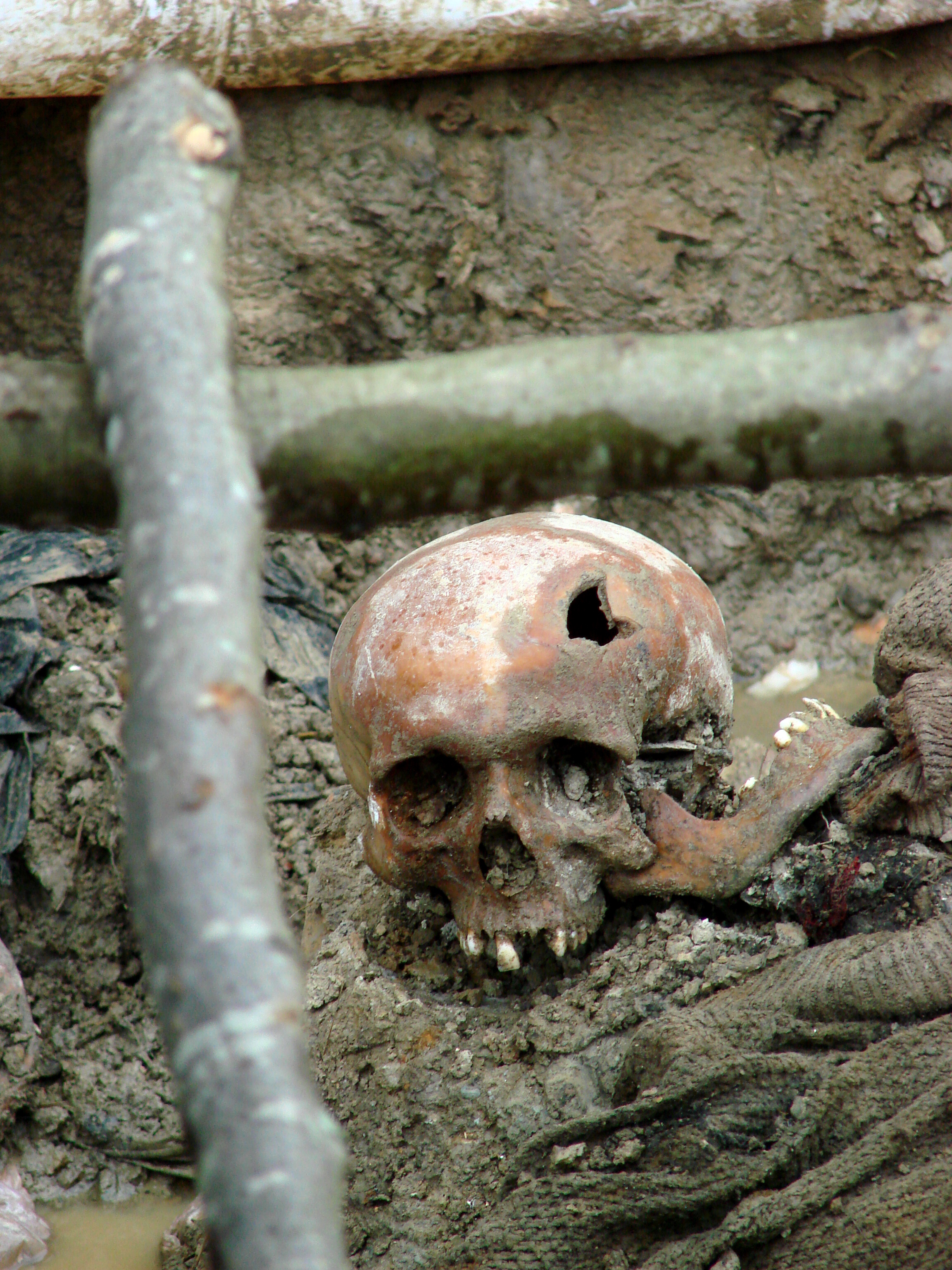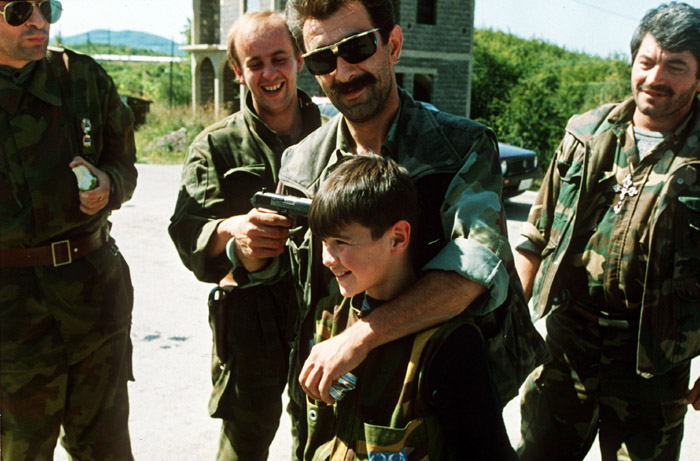This year marks the 20th anniversary of the Bosnian war '92-'96, part of a series of conflicts in the former Yugoslavia. It was also known as the conflict in the Balkans, War in Bosnia and Herzegovina. The conflict was a struggle between factions mainly the Serbs (predominantly Orthodox), Bosniaks (predominantly Muslims) and Bosnian Croats (predominantly Catholics) who refuse to see one from the other as rightful representative of their nation among other long-term hatred usually driven by nationalism. The conflict was notorious for its severe violence and indiscriminate bombings of known civilian areas and towns (for no strategic importance), mass-rape, random executions, massacres and ethnic cleansing.
Families divide, lifelong friends become enemies in this war.
Little history on how this nation turn to a powder keg and exploded later on in the 20th century becoming the most devastating conflict in Europe since World War II.
- 1941 Germany invades Yugoslavia, and establishes a Nazi puppet regime, The Independent State of Croatia.
- 1946 Partisan Leader and National Hero Josip Broz Tito (Marshall Tito), forms the nation of the Federal Peoples Republic of Yugoslavia. It is modeled after the communist Soviet Union and consists of six republics. The Socialist Republic of Bosnia and Herzegovina is one of them.
- 1946-1980. Marshall Tito is a dictator who ruled Yugoslavia with an iron fist. Because of this, ethnic and religious tensions that had always existed in this area were repressed and a relative peace maintained during Tito's reigned.
- 1980. Marshall Tito dies.
- 1980-1990. Ethnic tensions begin to rise again in Yugoslavia. The three main groups of the tensions were Serbia, Croatia and Bosnia-Herzegovina. In the late 1980's, when the Soviet Union was breaking up, Nationalistic pride and fever swept through this Balkan area. The individual states began to want to breakaway from the Yugoslavian Republic.
- 1990-1991 Three major political-nationalistic parties form in Bosnia-Herzegovina in-accordance-with their population ethnicity; 43% were Bosnians (Muslim) (Party of Democratic Action), 31% were Serbs (Eastern Orthodox) (Serbian Democratic Party), and 17% were Croats (Roman Catholic) (Croatian Democratic Union)
- 1992 (Feb 29-March 1) There is a referendum vote for independence by Bosnia's Muslims and Croats. It is boycotted by Serbs. In April, after Bosnia's independence is recognized by the European Union, Civil War breaks out. The Serbs, receiving support from Serbia, lays siege to the Bosnian Capital city, Sarajevo and control 70 % of Bosnia.
Siege of Sarajevo (Sa-ra-ye-vo)5 April 1992 – 29 February 1996
Serbian soldiers, stationed on mountains, besieged Sarajevo, December 1992.
Serbs operating in the countryside.
Foreign Islamists or Mujaheddin in Bosnia volunteered to fight for Islam and for the Muslim Bosniaks.
Serb Scorpion unit with captured Muslim mujahideen flag.
Bosnian army run through the streets. 1993
Croats
UN Peacekeeper in Bosnia 1993.
[IMG]http://4.bp.blogspot.com/_femhrxbNtS0/S1OG22ifmSI/AAAAAAAADY0/tdlgYTqXPnc*******mercenary_modern.jpg[/IMG]
Sniper in Sarajevo 1993. Bosnian war hosted hostile urban combat and are notorious for its 'sniper alleys'. This sniper in particular is a mercenary. All sides hired fighters from all over the world.
US involvement was usually through done from the distance, bombing Serb positions. This artwork depicts Capt. Robert Wright, flying in an F-16, shot down three Serb Galeb aircraft over Bosnia.
Serbian T-34.
A town fallen victim to indiscriminate killing.
Mass grave.
Results 1 to 10 of 41
Thread: Bosnian War 1992-1996
-
06-24-2012, 03:29 AM #1Banned User

- Join Date
- May 2012
- Gender

- Posts
- 1,464
 Yugoslav Wars/Bosnian War 1991- 2001 (20th Anniversary)
Yugoslav Wars/Bosnian War 1991- 2001 (20th Anniversary)
Last edited by machinecult; 07-11-2012 at 06:11 PM.
-
06-24-2012, 03:55 AM #2Banned User

- Join Date
- May 2012
- Gender

- Posts
- 1,464
 Re: Bosnian War 1992-1996
Re: Bosnian War 1992-1996
(continuation)

French soldiers in Bosnian airfield.

Czech and British Volunteers.

British and Czech volunteers with a Croatian.

Armed Bosniaks

Bosnian soldier patrol the streets of Sarajevo.

Bosnians take cover from Serbian fire.

A man and a woman hit by grenade shrapnel.

In Bosnia, personnel stationed in sniper alleys don't discriminate their target. They will shoot anyone who goes beyond the point they're not suppose to go...including children. Sometimes they just shoot because they can.

Bodies are piled on trucks after market attack in Sarajevo.

During the siege civilian casualties pile up in hospitals...

...and in morgues

One of the countless rape victims.

Building behind almost stripped from shelling and indiscriminate fire.


More sniper victims in 1992 and things like this will last until 1995!
Why war sucks? Observe these series of pictures.
Woman tries to wake up a relative after being shot...


...and gets herself and likely another relative killed.

being kicked around

Corpses litter the streets. 1994
Mass graves excavated later...

Srebrenica massacre of 8,000 men and boys, 30,000 women and children ethnically cleansed, many
women brutally raped.
Updates soon...Last edited by machinecult; 06-24-2012 at 02:55 PM.
-
06-24-2012, 08:33 AM #3
 Re: Bosnian War 1992-1996
Re: Bosnian War 1992-1996
I read a story, (I think it was also featured in History Channel) of a mercenary sniper, who will not eat until he killed 5 people between meals...
-
06-24-2012, 08:40 AM #4
 Re: Bosnian War 1992-1996
Re: Bosnian War 1992-1996
Kani sad ay, tan-awa ninyo ni, it's a true story about two snipers in the Bosnian War...

Last edited by balipseyev; 06-24-2012 at 05:05 PM.
-
06-24-2012, 11:51 AM #5Banned User

- Join Date
- May 2012
- Gender

- Posts
- 1,464
 Re: Bosnian War 1992-1996
Re: Bosnian War 1992-1996
^ Gi pasalida ni sa MGM months ago. I waited for it unya nalimtan pa gyud tan.aw.
Pero kita ko ani. Savior (1998- IMDb quite depressing film.Last edited by machinecult; 06-24-2012 at 11:57 AM.
-
06-24-2012, 01:26 PM #6Banned User

- Join Date
- May 2012
- Gender

- Posts
- 1,464
 Re: Bosnian War 1992-1996
Re: Bosnian War 1992-1996

WWII era Yugoslav Royalist flag (Chetniks flag) used by some nationalistic Serbs who advocate a 'Greater Serbia' though considered fascistic by most loyal to Republika Srpska - sympathetic to former Communist government.
inscription reads: "For king and fatherland; freedom or death"

UN peacekeeper inspecting heavily shelled district.

Bombed Mosque in Bosnia and Herzegovina 1993.


A Serb commander puts a gun to the head of his son as he and his friends joke around while waiting for a prisoner exchange near Sarajevo, summer of 1992.
Members of the NORWEGIAN Mechanized Battalion from Kongsberg, Norway, strap themselves inside a UH-60 Blackhawk helicopter during a joint United States and NORWEGIAN training exercise for rapid deployment of troops during Operation JOINT GUARD. JOINT GUARD is the multi-national peacekeeping mission that provides a climate of stability in the war-torn land of Bosnia-Herzegovina.
IFOR Troops were prepared to assist in possible disturbances during Mostar elections. With more than 2500 IFOR Troops securing the divided town, voting remained peaceful. The Mostar elections provided a crucial test for the Dayton Peace Accord which ended the 3 1/2 year war in Bosnia. Shown are the Spanish made BMR-600 varient VEC-25 6x6 Wheeled Armoured Reconnaissance Vehicle fitted with a TC25 turret armed with a 25mm M242 gun.
Norwegian IFOR soldieres meeting with the first US IFOR soldiers from the 1. US Armored Division between the Sava Rver and Tuzla in January 1996
A Russian BTR 80 Personnel Carrier (right) from the Russian Military Police, 1st Battalion Airborne Brigade, 76th Airborne Division parks next to a Bradley Fighting Vehicle from B troop, 3rd Squadron, 4th Cavalry Regiment, 2nd Brigade, 1st Armored Division for a moment during a joint patrol around the Serbian town of Zvornik on the afternoon of 29 February 96 in support of Operation Joint Endeavor.
UN Personnel serve as human shields in sniper alley. This was to pressure factions from accidentally killing UNPROFOR soldiers that'll cost them more global intervention. The UNPROFOR was then replaced by the IFOR
- The Implementation Force (IFOR) was a NATO-led multinational peacekeeping force in Bosnia and Herzegovina under a one-year mandate from 20 December 1995 to 20 December 1996 under the codename Operation Joint Endeavour.
First U.S. troops arrive for Bosnia mission November(?) 1995.





Last edited by machinecult; 06-24-2012 at 01:33 PM.
-
06-24-2012, 02:37 PM #7
-
06-24-2012, 03:04 PM #8
 Re: Bosnian War 1992-1996
Re: Bosnian War 1992-1996
The Bosnian War is one of the most hardest to understand conflicts in recent times. Anyway, when I was in elementary I had a friend whose family got out of Sarajevo after the siege. I'm not sure if they were either Croats or Bosniaks, most likely the latter. But she had an older brother who was sniped by Serbians during the siege. Oftentimes kuno, snipers shot at people just because they can.
Note: by 1994 there were only 2 belligerents, as the Bosnian Croats and Bosnian Muslims allied themselves against the Serbs.
-
06-24-2012, 04:08 PM #9Banned User

- Join Date
- May 2012
- Gender

- Posts
- 1,464
 Re: Bosnian War 1992-1996
Re: Bosnian War 1992-1996
They fled here in the Philippines? Wow they come a long way! From one multi-ethnic boiling cauldron to the 'next'. Hopefully our country will stay out of this divisive ethnoreligious-nationalistic pride nonsense but who knows (God-forbid) the future is limitless and clan-based, politically motivated violence, assassinations occurring in our country proves we are just as brutal to each other for minor differences. Its been a reason why despite the difficulty in understanding Yugoslav conflicts, Ireland Troubles, Wars in Chechnya and the like interest me. I think these conflicts were fueled by human nature trying to establish a sort of 'love' for country but with terrible results.
-
06-24-2012, 05:08 PM #10
 Re: Bosnian War 1992-1996
Re: Bosnian War 1992-1996
This war happened because of the false pride and arrogant behavior of the ethnic Serbs minority in Bosnia and Herzegovina. Supported and driven by neighboring Serbia’s irredentist ideology which is called “The Greater Serbia”, in wanton disregard of civilian lives the Serbs engage in the most horrific genocide and ethnic cleansing history of mankind, “The Genocide of Bosnian Muslims”. Though the main proponent of this conflict was already dead while serving his sentence in prison and his country Serbia was cleared by ICJ of genocides still the question remains, Is the justice been serve to the Bosnian Muslims?

Advertisement
Similar Threads |
|

















 Reply With Quote
Reply With Quote

